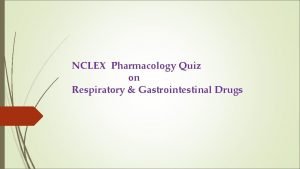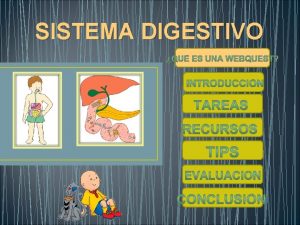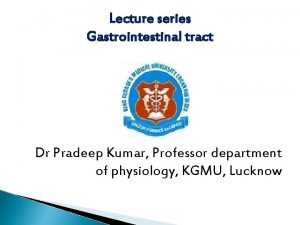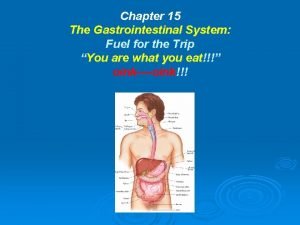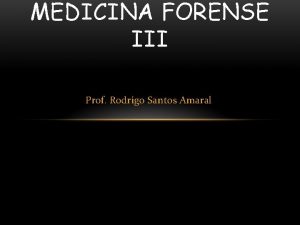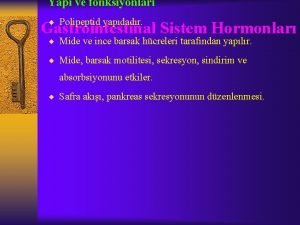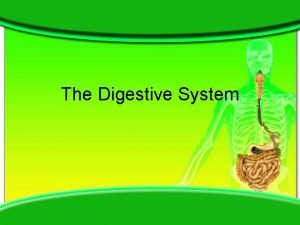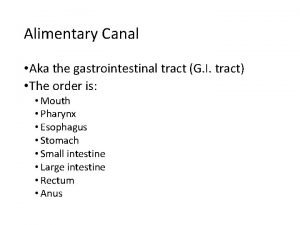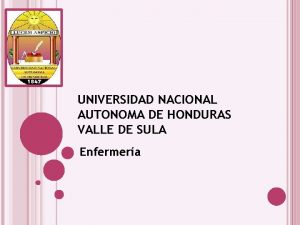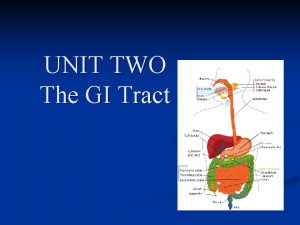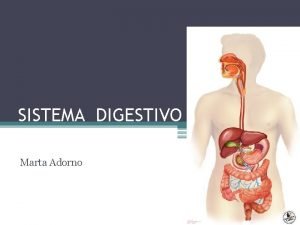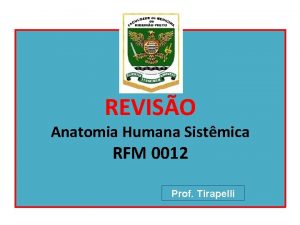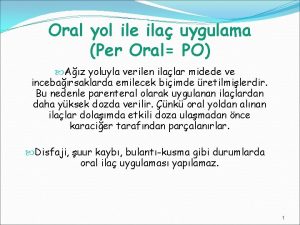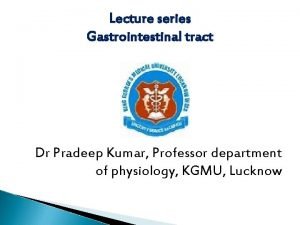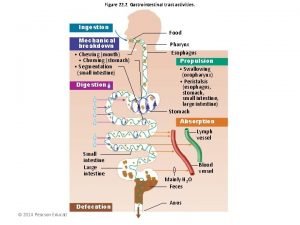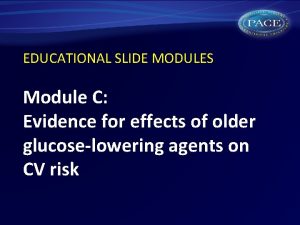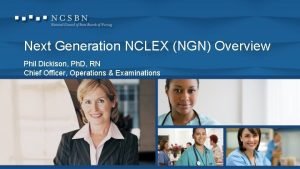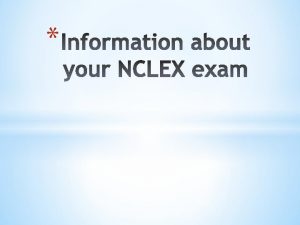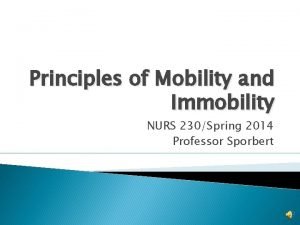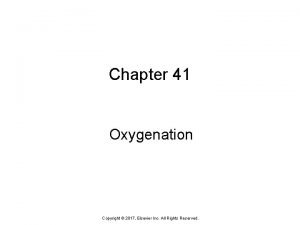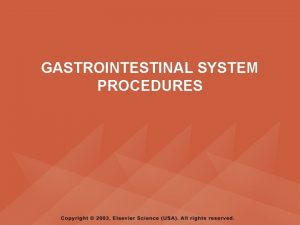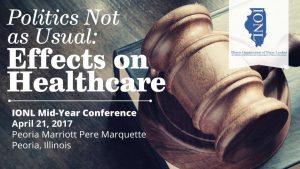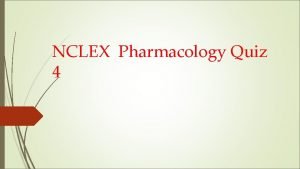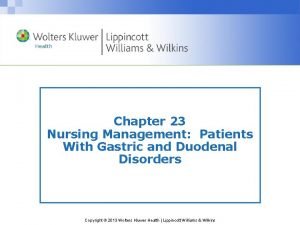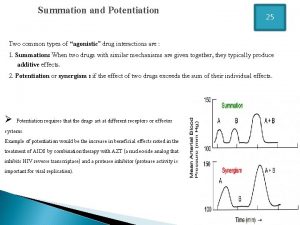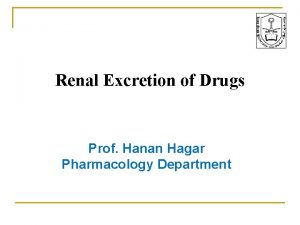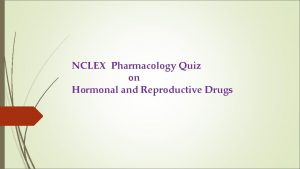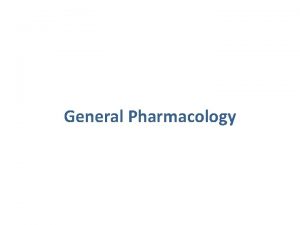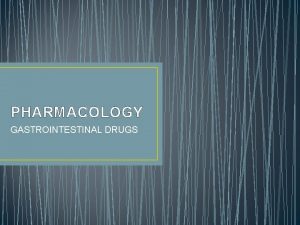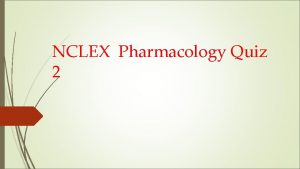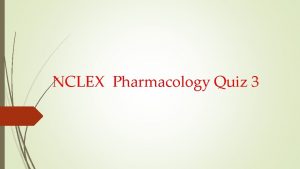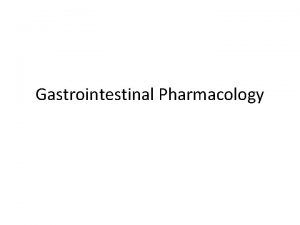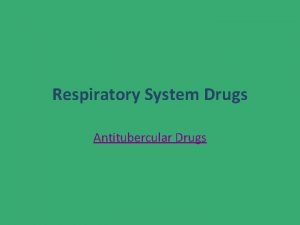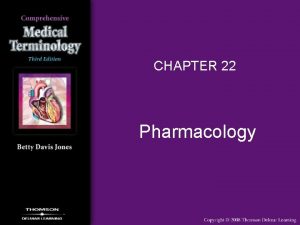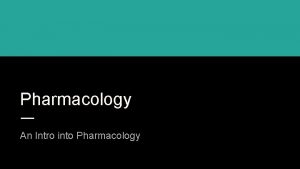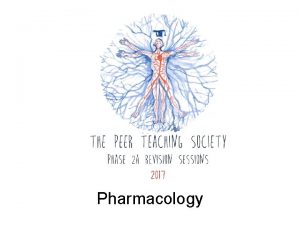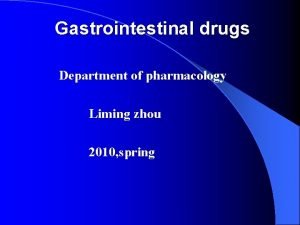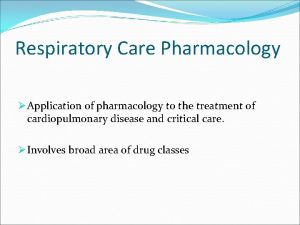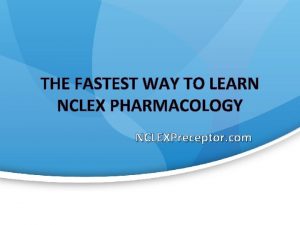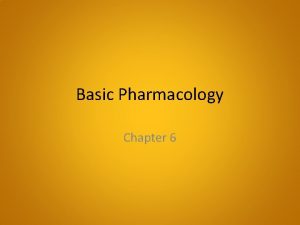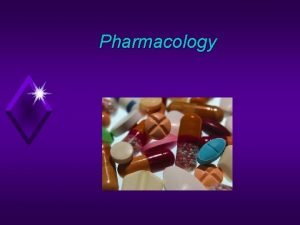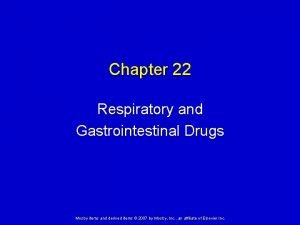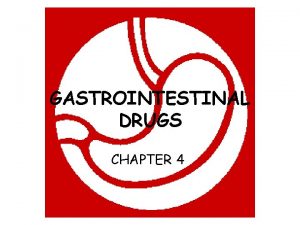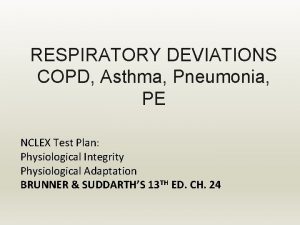NCLEX Pharmacology Quiz on Respiratory Gastrointestinal Drugs 1











































- Slides: 43

NCLEX Pharmacology Quiz on Respiratory & Gastrointestinal Drugs

1. Nurse Rita is giving instructions to her client who is taking antihistamine. Which of the following nurse teachings is appropriate for the client? A. Avoid ingesting alcohol. B. Be aware that you may need to take a decongestant. C. Be aware that you may have increased saliva. D. Expect a relief in 24 hours. 1. The correct answer is: A. Avoid ingesting alcohol. Because alcohol and antihistamines have sedating properties, concurrent administration of these drugs should be avoided. Antihistamines and decongestants are often given together. Dry mouth is a common side effect, not increased salivation. Not all antihistamines last 24 hours.

2. Daniel has vertigo, which antihistamine is best for his condition? A. Terfenadine B. Meclizine C. Hydrocodone D. Guaifenesin 2. The correct answer is: B. Meclizine (Antivert) is given for vertigo and motion sickness. Choices C and D are not antihistamines. Choice A is an antihistamine, but meclizine is the standard drug in the treatment of vertigo.

3. Raul, a 20 -year-old student, used to buy OTC drugs whenever he feels sick. Which of the following statements best describes the danger of self-medication with over-the-counter drugs? A. Clients are not aware of the action of over-the-counter drugs. B. Clients are not aware of the side effects of over-the-counter drugs. C. Clients minimize the effects of over-the-counter drugs because they are available without prescription. D. Clients do not realize the effects of over-the-counter drugs. 3. The correct answer is: C. Clients minimize the effects of over-thecounter drugs because they are available without prescription. This choice is correct because it includes the other three risks noted in choices A, B, and D.

4. Shenaya will be having her exam in pharmacology tomorrow. She should be aware that antitussive is indicated to: A. encourage removal of secretions through coughing. B. relieve rhinitis. C. control a productive cough. D. relieve a dry cough. 4. The correct answer is: D. relieve a dry cough. An antitussive is a cough suppressant. Choices A and C describe the action of an expectorant. Choice D describes the action of a decongestant.

5. The nurse should instruct a client who is taking an expectorant to: A. restrict fluids. B. increase fluids. C. avoid vaporizers. D. take antihistamines. 5. The correct answer is: B. increase fluids. Increasing fluids will help liquefy secretions and facilitate removal.

6. When administering the methylxanthine theophylline, the nurse can expect: A. Decreased pulmonary function B. Increased pulmonary function C. Increased residual volume B. Decreased tidal volume 6. The correct answer is: B. Increased pulmonary function Theophylline will improve ventilation so there will be an overall improvement of pulmonary measurements. Other choices are the opposite of what will actually occur with theophylline administration.

7. A client with which of the following conditions may experience a dangerous or fatal side effect of theophylline? A. Cardiac disorder B. Diabetes C. Renal disease D. Hepatic disease 7. The correct answer is: A. Cardiac disorder A client with a heart condition may experience dangerous stimulation from this drug. Theophylline should be administered cautiously with all the other choices, but consequences are most dangerous or possibly fatal for clients with a heart condition.

8. To evaluate the effectiveness of theophylline therapy, which of the following laboratory values must be drawn? A. Glucose B. Hematocrit C. Potassium D. Theophylline lev 8. The correct answer is: D. Theophylline levels must be drawn to determine if the drug is present in therapeutic amounts in the client’s serum.

9. The effects of theophylline may be increased by: A. Phenobarbital B. Phenytoin C. Rifampin D. Cimetidine 9. The correct answer is: D. Cimetidine will increase the effects of theophylline.

10. Which of the following statements describes the action of antacids? A. Antacids neutralize gastric acid. B. Antacids block the production of gastric acid. C. Antacids block dopamine. D. Antacids enhance action of acetylcholine. 10. The correct answer is: A. Antacids neutralize gastric acid. Antacids act to bring the p. H above 3. Other choices are incorrect because they describe actions of antiacid drugs.

11. Jam is under chemotherapy in which nausea is an expected side effect. Which of the following drugs is indicated to prevent such side effect? A. metoclopramide B. cimetidine C. Tagamet D. famotidine 11. The correct answer is: A. metoclopramide This is the only drug among the choices that is indicated to prevent nausea.

12. Which of the following drugs will reduce the effectiveness of sucralfate? A. ranitidine B. Carafate C. metoclopramide D. meclizine 12. The correct answer is: A. ranitidine Ranitidine decreases the effectiveness of sucralfate because it decreases the acid content of gastric secretion. Choice B is the trade name for sucralfate. Choice C is a gastric stimulant that does not alter p. H. Choice D is an antihistamine and its GI effect is antiemetic.

13. Extrapyramidal symptoms are a side effect of which of the following drugs? A. ranitidine B. omeprazole C. famotidine D. metoclopramide 13. The correct answer is: D. metoclopramide A side effect of metoclopramide is EPS.

14. Which histamine-2 antagonist is associated with the most drug interactions? A. ranitidine B. cimetidine C. Prilosec D. nizatidine 14. The correct answer is: B. cimetidine Cimetidine was the first histamine-2 antagonist developed and is associated with the most toxic drug interactions of the group.

15. Hydrochloric acid secretion is blocked by which of the following category of drugs? A. antacids B. gastric stimulants C. histamine-2 antagonists D. antihistamines 15. The correct answer is: C. histamine-2 antagonists This is the only category of drugs that reduces the volume of secretions.

16. Which category of drugs prevents/treats constipation by the osmotic drawing of water from extravascular space to intestinal lumen? A. Stimulants B. Bulk-forming agents C. Hyperosmotic agents D. Lubricants 16. The correct answer is: C. Hyperosmotic agents change the osmotic gradient between the intestine and extravascular space causing water to move into the intestinal lumen and balance the gradient.

17. Which of the following is a bulk-forming agent? A. glycerin B. lactulose C. Fiber. Con D. Milk of Magnesia 17. The correct answer is: C. Fiber. Con is the bulk-forming agent. Choices A and B are incorrect because they are hyperosmotic agents. Choice D, meanwhile, is a saline laxative.

18. A client needs rapid cleansing of the bowel, which category is best used? A. Bacid B. Bulk-forming agent C. Saline laxatives with magnesium D. Intestinal flora modifiers 18. The correct answer is: C. Saline laxatives with magnesium Saline laxatives are the best agents for rapid bowel cleansing. Bacid is an intestinal flora modifier. Bulk-forming agents will not produce rapid cleansing. Intestinal flora modifiers will not produce rapid cleansing as well.

19. Which of the following categories is used for diarrhea and constipation? A. Bulk-forming agents B. Intestinal flora modifiers C. Cascara D. Milk of Magnesia 19. The correct answer is: A. Bulk-forming agents are used for diarrhea and constipation.

20. Which of the following may be used for a bowel preparation and is not recommended for treatment of constipation? A. Correctol B. Fiberall C. mineral oil D. castor oil 20. The correct answer is: D. castor oil Castor oil is not recommended for treatment of constipationbecause it causes such severe abdominal pain.






















 Pharmacology of drugs acting on respiratory system
Pharmacology of drugs acting on respiratory system Respiratory pharmacology quiz
Respiratory pharmacology quiz Adrenal drugs pharmacology
Adrenal drugs pharmacology Conducting zone of the respiratory system function
Conducting zone of the respiratory system function Embriologia del sistema gastrointestinal
Embriologia del sistema gastrointestinal Gastrointestinal tract
Gastrointestinal tract Chemotrypsinogen
Chemotrypsinogen Emt chapter 18 gastrointestinal and urologic emergencies
Emt chapter 18 gastrointestinal and urologic emergencies Chapter 15 the gastrointestinal system
Chapter 15 the gastrointestinal system Gastrointestinal hormones
Gastrointestinal hormones Malrotasi traktus gastrointestinal
Malrotasi traktus gastrointestinal Docimasia gastrointestinal
Docimasia gastrointestinal Sekretin ailesi
Sekretin ailesi Gastrointestinal medical terminology breakdown
Gastrointestinal medical terminology breakdown Nutrition focused physical findings
Nutrition focused physical findings Forgut midgut hindgut
Forgut midgut hindgut Composition of stomach
Composition of stomach Motilidad gastrointestinal
Motilidad gastrointestinal Upper gi bleeding management
Upper gi bleeding management A digestão começa na boca
A digestão começa na boca Identifique
Identifique What is gastrointestinal disease
What is gastrointestinal disease Sublingual ilaç uygulaması
Sublingual ilaç uygulaması Gastrointestinal structure
Gastrointestinal structure Gastrointestinal
Gastrointestinal Why does metformin cause gastrointestinal problems
Why does metformin cause gastrointestinal problems Distal organ
Distal organ Hirschsprung disease nursing management
Hirschsprung disease nursing management Nursing management of gastrointestinal disorders
Nursing management of gastrointestinal disorders Ncsbn model of clinical judgement
Ncsbn model of clinical judgement Next gen nclex
Next gen nclex Ncsbn stands for
Ncsbn stands for Nclex style questions examples
Nclex style questions examples Nclex questions on mobility and immobility
Nclex questions on mobility and immobility Chapter 41: oxygenation nclex questions
Chapter 41: oxygenation nclex questions Miller-abbott tube nursing
Miller-abbott tube nursing Idphnet.illinois.gov
Idphnet.illinois.gov Cloze items nclex
Cloze items nclex Blood transfusion steps nclex
Blood transfusion steps nclex Nursing management of duodenal ulcer
Nursing management of duodenal ulcer Pharmacology and venipuncture in radiology pdf
Pharmacology and venipuncture in radiology pdf Potentiation example
Potentiation example Rate of elimination of drug
Rate of elimination of drug What is ion trapping in pharmacology
What is ion trapping in pharmacology

